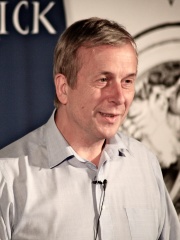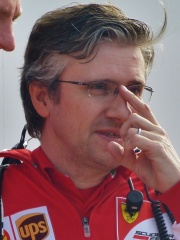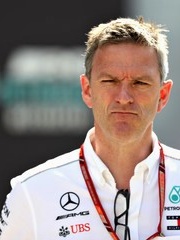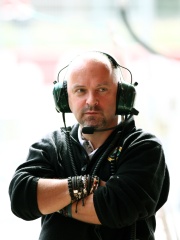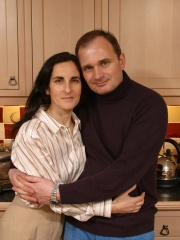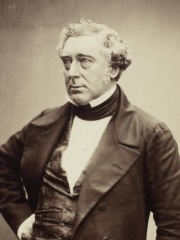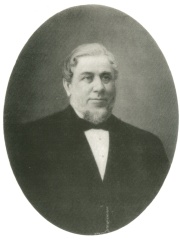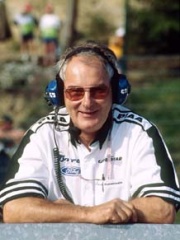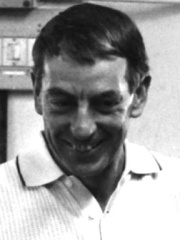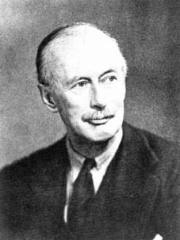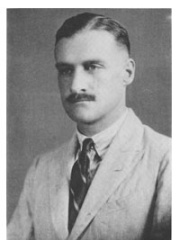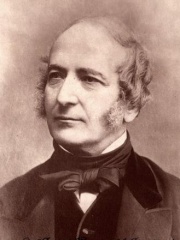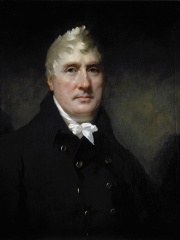
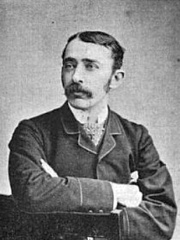
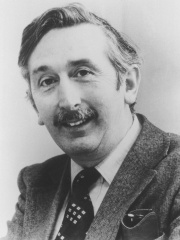
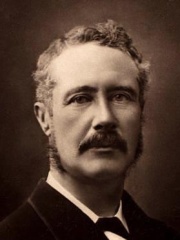
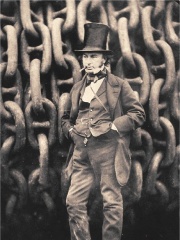
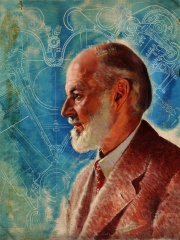
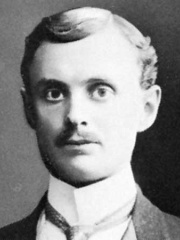
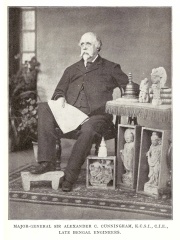
The Most Famous
ENGINEERS from United Kingdom
This page contains a list of the greatest British Engineers. The pantheon dataset contains 389 Engineers, 50 of which were born in United Kingdom. This makes United Kingdom the birth place of the 2nd most number of Engineers.
Top 10
The following people are considered by Pantheon to be the top 10 most legendary British Engineers of all time. This list of famous British Engineers is sorted by HPI (Historical Popularity Index), a metric that aggregates information on a biography’s online popularity. Visit the rankings page to view the entire list of British Engineers.

1. William John Macquorn Rankine (1820 - 1872)
With an HPI of 62.07, William John Macquorn Rankine is the most famous British Engineer. His biography has been translated into 57 different languages on wikipedia.
William John Macquorn Rankine (; 5 July 1820 – 24 December 1872) was a Scottish mathematician and physicist. He was a founding contributor, with Rudolf Clausius and William Thomson (Lord Kelvin), to the science of thermodynamics, particularly focusing on its First Law. He developed the Rankine scale, a Fahrenheit-based equivalent to the Celsius-based Kelvin scale of temperature. Rankine developed a complete theory of the steam engine and indeed of all heat engines. His manuals of engineering science and practice were used for many decades after their publication in the 1850s and 1860s. He published several hundred papers and notes on science and engineering topics, from 1840 onwards, and his interests were extremely varied, including, in his youth, botany, music theory and number theory, and, in his mature years, most major branches of science, mathematics and engineering. He was an enthusiastic amateur singer, pianist and cellist who composed his own humorous songs.

2. John Ambrose Fleming (1849 - 1945)
With an HPI of 61.32, John Ambrose Fleming is the 2nd most famous British Engineer. His biography has been translated into 34 different languages.
Sir John Ambrose Fleming FRS (29 November 1849 – 18 April 1945) was an English electrical engineer and physicist who invented the first thermionic valve or vacuum tube, designed the radio transmitter with which the first transatlantic radio transmission was made, and also established the right-hand rule used in physics. He was the eldest of seven children of James Fleming DD (died 1879), a Congregational minister, and his wife Mary Ann, at Lancaster, Lancashire, and baptised on 11 February 1850. A devout Christian, he once preached at St Martin-in-the-Fields in London on evidence for the resurrection. In 1932, he and Douglas Dewar and Bernard Acworth helped establish the Evolution Protest Movement. Fleming bequeathed much of his estate to Christian charities, especially those for the poor. He was a noted photographer, painted watercolours, and enjoyed climbing the Alps.

3. Godfrey Hounsfield (1919 - 2004)
With an HPI of 60.99, Godfrey Hounsfield is the 3rd most famous British Engineer. His biography has been translated into 50 different languages.
Sir Godfrey Newbold Hounsfield ( HOWNZ-feeld; 28 August 1919 – 12 August 2004) was a British electrical engineer who shared the 1979 Nobel Prize for Physiology or Medicine with Allan MacLeod Cormack for his part in developing the diagnostic technique of X-ray computed tomography (CT). His name is immortalised in the Hounsfield scale, a quantitative measure of radiodensity used in evaluating CT scans. The scale is defined in Hounsfield units (symbol HU), running from air at −1000 HU, through water at 0 HU, and up to dense cortical bone at +1000 HU and more.

4. Charles George Gordon (1833 - 1885)
With an HPI of 60.89, Charles George Gordon is the 4th most famous British Engineer. His biography has been translated into 41 different languages.
Major-General Charles George Gordon CB (28 January 1833 – 26 January 1885), also known as Chinese Gordon, Gordon Pasha, and Gordon of Khartoum, was a British Army officer and administrator. He saw action in the Crimean War as an officer in the British Army. However, he made his military reputation in China, where he was placed in command of the "Ever Victorious Army", a force of Chinese soldiers led by European officers which was instrumental in putting down the Taiping Rebellion, regularly defeating much larger forces. For these accomplishments, he was given the nickname "Chinese Gordon" and honours from both the Emperor of China and the British. He entered the service of the Khedive of Egypt in 1873 (with British government approval) and later became the Governor-General of the Sudan, where he did much to suppress revolts and the local slave trade. He then resigned and returned to Europe in 1880. A serious revolt then broke out in the Sudan, led by a Muslim religious leader and self-proclaimed Mahdi, Muhammad Ahmad. In early 1884, Gordon was sent to Khartoum with instructions to secure the evacuation of loyal soldiers and civilians and to depart with them. In defiance of those instructions, after evacuating about 2,500 civilians, he retained a smaller group of soldiers and non-military men. In the months before the fall of Khartoum, Gordon and the Mahdi corresponded; Gordon offered him the sultanate of Kordofan and the Mahdi requested Gordon to convert to Islam and join him, which Gordon declined. Besieged by the Mahdi's forces, Gordon organised a citywide defence that lasted for almost a year and gained him the admiration of the British public, but not of the government, which had wished him not to become entrenched there. Only when public pressure to act had become irresistible did the government, with reluctance, send a relief force. It arrived two days after the city had fallen and Gordon had been killed.
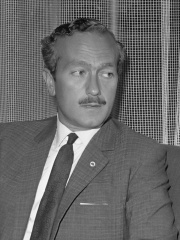
5. Colin Chapman (1928 - 1982)
With an HPI of 59.56, Colin Chapman is the 5th most famous British Engineer. His biography has been translated into 30 different languages.
Anthony Colin Bruce Chapman (19 May 1928 – 16 December 1982) was an English design engineer, inventor, and builder in the automotive industry, and founder of the sports car company Lotus Cars. Chapman founded Lotus in 1952 and initially ran Lotus in his spare time, assisted by a group of enthusiasts. His knowledge of the latest aeronautical engineering techniques would prove vital towards achieving the major automotive technical advances for which he is remembered. Chapman's design philosophy focused on cars with light weight and fine handling instead of bulking up on horsepower and spring rates, which he famously summarised as "Adding power makes you faster on the straights. Subtracting weight makes you faster everywhere." Team Lotus won seven Formula One Constructors' titles, six Drivers' Championships, and the Indianapolis 500 in the United States, between 1962 and 1978 under his direction. The production side of Lotus Cars has built tens of thousands of relatively affordable, cutting edge sports cars. Lotus is one of but a handful of English performance car builders still in business after the industrial decline of the 1970s. Chapman suffered a fatal heart attack in 1982, aged 54.

6. Isambard Kingdom Brunel (1806 - 1859)
With an HPI of 59.48, Isambard Kingdom Brunel is the 6th most famous British Engineer. His biography has been translated into 50 different languages.
Isambard Kingdom Brunel (; 9 April 1806 – 15 September 1859) was a British civil engineer and mechanical engineer who is considered "one of the most ingenious and prolific figures in engineering history", "one of the 19th-century engineering giants", and "one of the greatest figures of the Industrial Revolution, [who] changed the face of the English landscape with his groundbreaking designs and ingenious constructions". Brunel built dockyards, the Great Western Railway (GWR), a series of steamships including the first purpose-built transatlantic steamship, and numerous important bridges and tunnels. His designs revolutionised public transport and modern engineering. Though Brunel's projects were not always successful, they often contained innovative solutions to long-standing engineering problems. During his career, Brunel achieved many engineering firsts, including assisting his father in the building of the first tunnel under a navigable river (the River Thames) and the development of the SS Great Britain, the first propeller-driven, ocean-going iron ship, which, when launched in 1843, was the largest ship ever built. On the GWR, Brunel set standards for a well-built railway, using careful surveys to minimise gradients and curves. This necessitated expensive construction techniques, new bridges, new viaducts, and the two-mile-long (3.2 km) Box Tunnel. One controversial feature was the "broad gauge" of 7 ft 1⁄4 in (2,140 mm), instead of what was later to be known as "standard gauge" of 4 ft 8+1⁄2 in (1,435 mm). He astonished Britain by proposing to extend the GWR westward to North America by building steam-powered, iron-hulled ships. He designed and built three ships that revolutionised naval engineering: the SS Great Western (1838), the SS Great Britain (1843), and the SS Great Eastern (1859). In 2002, Brunel was placed second in a BBC public poll to determine the "100 Greatest Britons". In 2006, the bicentenary of his birth, a major programme of events celebrated his life and work under the name Brunel 200.

7. Henry Royce (1863 - 1933)
With an HPI of 58.68, Henry Royce is the 7th most famous British Engineer. His biography has been translated into 40 different languages.
Sir Frederick Henry Royce, 1st Baronet, (27 March 1863 – 22 April 1933) was an English engineer famous for his designs of car and aeroplane engines with a reputation for reliability and longevity. With Charles Rolls (1877–1910) and Claude Johnson (1864–1926), he founded Rolls-Royce. Rolls-Royce initially focused on large 40–50 horsepower motor cars, the Silver Ghost and its successors. Royce produced his first aero engine shortly after the outbreak of the First World War, and aircraft engines became Rolls-Royce's principal product. Royce's health broke down in 1911, and he was persuaded to leave his factory in the Midlands at Derby and, taking a team of designers, move to the south of England spending winters in the south of France. He died at his home in Sussex in the spring of 1933.

8. Charles Rolls (1877 - 1910)
With an HPI of 57.81, Charles Rolls is the 8th most famous British Engineer. His biography has been translated into 38 different languages.
Charles Stewart Rolls (27 August 1877 – 12 July 1910) was a British motoring and aviation pioneer. With Henry Royce, he co-founded the Rolls-Royce car manufacturing firm. He was the first Briton to be killed in an aeronautical accident with a powered aircraft, when the tail of his Wright Flyer broke off during a flying display in Bournemouth. He was aged 32.

9. Alexander Cunningham (1814 - 1893)
With an HPI of 57.45, Alexander Cunningham is the 9th most famous British Engineer. His biography has been translated into 37 different languages.
Major General Sir Alexander Cunningham (23 January 1814 – 28 November 1893) was a British Army engineer with the Bengal Engineer Group who later took an interest in the history and archaeology of India. In 1861, he was appointed to the newly created position of archaeological surveyor to the government of India; and he founded and organised what later became the Archaeological Survey of India. He wrote numerous books and monographs and made extensive collections of artefacts. Some of his collections were lost, but most of the gold and silver coins and a fine group of Buddhist sculptures and jewellery were bought by the British Museum in 1894. He was also the father of mathematician Allan Cunningham.
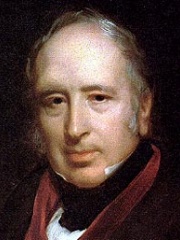
10. George Cayley (1773 - 1857)
With an HPI of 57.10, George Cayley is the 10th most famous British Engineer. His biography has been translated into 35 different languages.
Sir George Cayley, 6th Baronet (27 December 1773 – 15 December 1857) was an English engineer, inventor, and aviator. He is one of the most important people in the history of aeronautics. Many consider him to be the first true scientific aerial investigator and the first person to understand the underlying principles and forces of flight and the first man to create the wire wheel. In 1799, he set forth the concept of the modern aeroplane as a fixed-wing flying machine with separate systems for lift, propulsion, and control. He was a pioneer of aeronautical engineering and is sometimes referred to as "the father of aviation." He identified the four forces which act on a heavier-than-air flying vehicle: weight, lift, drag and thrust. Modern aeroplane design is based on those discoveries and on the importance of cambered wings, also proposed by Cayley. He constructed the first flying model aeroplane and also diagrammed the elements of vertical flight. He also designed the first glider reliably reported to carry a human aloft. He correctly predicted that sustained flight would not occur until a lightweight engine was developed to provide adequate thrust and lift. The Wright brothers acknowledged his importance to the development of aviation. Cayley represented the Whig party as Member of Parliament for Scarborough from 1832 to 1835, and in 1838, helped found the UK's first Polytechnic Institute, the Royal Polytechnic Institution (now University of Westminster) and served as its chairman for many years. He was elected as a Vice-President of the Yorkshire Philosophical Society in 1824. He was a founding member of the British Association for the Advancement of Science and was a distant cousin of the mathematician Arthur Cayley.
People
Pantheon has 56 people classified as British engineers born between 1693 and 1972. Of these 56, 12 (21.43%) of them are still alive today. The most famous living British engineers include Adrian Newey, Patrick Head, and Pat Symonds. The most famous deceased British engineers include William John Macquorn Rankine, John Ambrose Fleming, and Godfrey Hounsfield. As of April 2024, 8 new British engineers have been added to Pantheon including John Hughes, Harvey Postlethwaite, and Ron Tauranac.
Living British Engineers
Go to all RankingsAdrian Newey
1958 - Present
HPI: 56.91
Patrick Head
1946 - Present
HPI: 55.07
Pat Symonds
1953 - Present
HPI: 47.49
Kevin Warwick
1954 - Present
HPI: 41.66
Pat Fry
1964 - Present
HPI: 41.39
James Allison
1968 - Present
HPI: 40.97
Mike Gascoyne
1963 - Present
HPI: 40.40
Mike Coughlan
1959 - Present
HPI: 40.36
Bob Bell
1958 - Present
HPI: 40.13
Charles Ingram
1963 - Present
HPI: 39.32
James Key
1972 - Present
HPI: 36.69
James Guthrie
1953 - Present
HPI: 36.48
Deceased British Engineers
Go to all RankingsWilliam John Macquorn Rankine
1820 - 1872
HPI: 62.07
John Ambrose Fleming
1849 - 1945
HPI: 61.32
Godfrey Hounsfield
1919 - 2004
HPI: 60.99
Charles George Gordon
1833 - 1885
HPI: 60.89
Colin Chapman
1928 - 1982
HPI: 59.56
Isambard Kingdom Brunel
1806 - 1859
HPI: 59.48
Henry Royce
1863 - 1933
HPI: 58.68
Charles Rolls
1877 - 1910
HPI: 57.81
Alexander Cunningham
1814 - 1893
HPI: 57.45
George Cayley
1773 - 1857
HPI: 57.10
Hertha Ayrton
1854 - 1923
HPI: 57.03
Robert Stephenson
1803 - 1859
HPI: 56.49
Newly Added British Engineers (2024)
Go to all RankingsJohn Hughes
1814 - 1889
HPI: 53.64
Harvey Postlethwaite
1944 - 1999
HPI: 50.81
Ron Tauranac
1925 - 2020
HPI: 46.65
Harry Ricardo
1885 - 1974
HPI: 43.58
Ralph Bagnold
1896 - 1990
HPI: 42.55
John Scott Russell
1808 - 1882
HPI: 40.10
Charles Ingram
1963 - Present
HPI: 39.32
John Rennie the Elder
1761 - 1821
HPI: 38.89
Overlapping Lives
Which Engineers were alive at the same time? This visualization shows the lifespans of the 25 most globally memorable Engineers since 1700.




